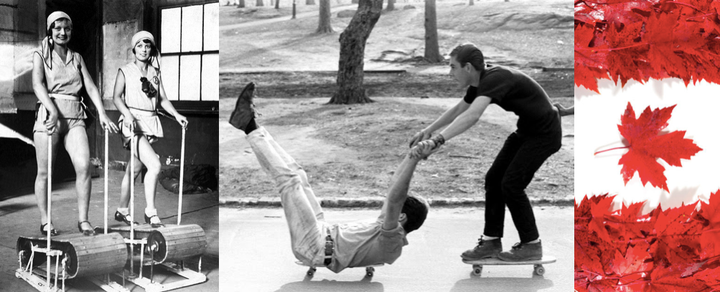
Not your grandmothers exercise program ... kids in Canada are getting fit and staying active, and donating their burned calories to kids in Somalia who need them.
Hello Canada! Greetings from the USA! Hope Thanksgiving went well. We sort of missed the memo it was even happening... sorry about that! We sure are thankful for you being such good neighbors. Accordingly, we have no walls planned any time soon.
As an American sitting just south of you, I must admit I am a little jealous of your annual early October Thanksgiving Day date. Our late November Thursday date is awful close to Christmas and at a time where the Fall theme has started to give way to more of a Wintery feeling. Yours is solidly Fall! The maple leaves are a million shades of red and gold... indeed If we were more informed about your Thanksgiving, we might just be jealous.
While our Thanksgiving traditions have their small differences, I suspect there is one troubling similarity. We both tend to spend that day with family and friends sitting around and eating way too much. Taking in too much fuel. Too many calories. I get the impression that your Thanksgiving, like ours, is marked by couches, Tryptophan-induced naps and second helpings. That’s why it’s so cool that a group of innovative young Canadians at Heritage Woods Secondary School have an idea that could offer all of Canada a way to not just burn off all those extra calories, but to actually collect and redistribute (or donate) those calories to people in need. It’s timely given this weeks news of numbers of overweight teens increasing 10x in the last 40 years! More about that below, but I think first a few observations about why we even have Thanksgiving celebrations may put it in context.
I guess if we were to look back at the cultural reasons around the world for harvest time feasts and celebrations we'd see they all share a common footing. They began as times where a bunch of people living in agriculturally based economies, gathered to thank their Gods, the moon, the stars, the rain...whatever it was, for actually having enough food stored away as they faced a tough winter. That was it. The harvest was in. It was time to feast and celebrate. If not celebrate abundance, at least celebrate the fact that it looked like survival was either possible or likely. It was time to be thankful. Given the way you guys get snowed in, I'm thinking this survival-thankfulness was a tad more pressing and heart-felt than people living in, say, Florida.
Regardless of the harshness of winters, both Canadians and your American neighbors to the south share a common theme when it comes to these annual Thanksgiving celebrations. That common theme is abundance. We both grow and harvest way more food than we need. More than we could ever eat. More than we could ever use. It's worth noting that a couple things tend to happen to people who live in this sort of abundance:
1) People who live in this sort of abundance tend to attribute their abundance to themselves. That was the safeguard of the ancient traditions of "thanksgiving". People gathered to humbly lift their eyes and hearts to the heavens and acknowledge that THEY did not do it. Indigenous people knew mother earth had provided. The Europeans who joined them on these lands looked to their Christian God with humble thanks. We have in our roots as Canadians and Americans a great tradition of not thinking too highly of ourselves, but instead of pausing to say thanks. Yet today we struggle with this. Certainly hard work and ingenuity play a huge role in North America's abundance, but when it comes to food, a big part of our abundance comes from that fact that we stumbled upon the world's most fertile soils and they produce like none other. To borrow an American baseball analogy, we were born on third base and often think we hit a triple.
2) People who live in this sort of abundance start thinking its normal. We tend to forget that having way too much food is not really the norm on our globe. In fact, in too many places just the opposite is true. As we in Canada and the US struggle with abundance and over-nutrition, more than half the world struggles with lack of food and under-nutrition. As Raj Patel said in his book a few years back, we live in a world that is simultaneously "Stuffed and Starved". Our entire globe seems to be struggling with a dysfunctional relationship with food, and it's quite literally killing us!
Which brings us back to the kids at Heritage Woods Secondary School in Port Moody, British Columbia. They said to themselves, what if we stopped looking at this stuffed and starved problem of our globe as two wildly different issues, but saw them instead as two sides of the same coin? The students at Heritage Woods have learned in their economics classes that abundance and scarcity are inextricably tied in economic theory. (The Nobel Prize in economics awarded this week supports these kids behavior focus by the way!) So they are asking, what if we took our abundance and actually used it to balance the scarcity in another part of the globe? We've always known that was a way to motivate people to give dollars. But what about giving something else? What about giving of our energy by getting active?
That's what Heritage Woods students will be doing starting on World Food Day 2017. Using their phones as trackers, they'll keep track of their activity as they partner with US-based Active for Good and Mana Nutrition to run what they are calling a "Move 4 Mana" challenge. Rather than focus on calories, and obesity and the negative side... these students are instead wisely focused on getting active. Sure, better choices around food are important, but the Heritage Woods students want to show us all that we all can get off the couch and get active. So when Heritage Woods students get active over a 30 day period starting at a huge World Food Day kick off October 16th, they will know that every step they take and every time they get active, they are actually "donating" that activity to children in need. Heritage Woods kids might not have a ton of money to give, but they do have a ton of energy...and they are about to start giving it! "I can't tell you how excited we are," says Marilyn Nunn, teacher at Heritage Woods. "This generation of kids has a heart to give and very wide world view. Move for Mana helps both our local community and the wider world."
So how does this all work? In keeping with the "it takes a village" mentality, two very important Canadian partners are stepping in to help make this all happen. The first is Langley, BC based Food for Famine Society who will actually match the donated energy that these kids collect on their phones. So every time Heritage Woods students get moving, ride their bikes, go for a hike, go to the gym...any sort of physical activity that they love...Food for Famine will take the donated activity and provide the money needed turn it into packets of RUTF... a specially formulated packet of medicine-food designed to feed and save the lives of severely malnourished children around the globe. Once these packets are created by the hard work and activity of Heritage Woods students, then World Vision Canada will step in and get those packets to children who need them most. This challenge will provide urgently needed RUTF for children who are being treated in nutrition centers by World Vision in places like Somalia and South Sudan.
So each partner plays their part. The students get active, Food for Famine matches their activity with dollars, and World Vision gets it to kids in need. As Maria Martini director of Food for Famine said of the partnership, "This has never been done before in Canada. Our youth are taking over in the fight for malnourished children. As they get active, we see the benefits of healthier happier Canadian kids, and we love that matching their activity has a double impact. We are addressing inactivity here...one of the biggest health issues that Canada has today, and at the same time fighting Severe Acute Malnutrition (SAM) in other parts of the world." World Vision VP Jamie McIntosh agrees, "If you think about it," says McIntosh, "we are unleashing the first ever group of true ACTIVISTS. Young people in Canada getting active for the good of the world and for their own good. It might be the best example of a win/win I have ever seen."
So as you come off a national time of Thanksgiving for our abundance and we look ahead to ours, let’s keep a watchful eye on those kids at Heritage Woods. They'll be going for a run, a bike ride, a hike and playing some soccer. And when they do, their activity and calories burned won't be wasted... they'll be collected and used to save lives. That's Canada generously sharing its great abundance in a whole new way!
Mark Moore is the CEO of Mana Nutrition, producer of RUTF and frequent contributor to Huffington Post.
